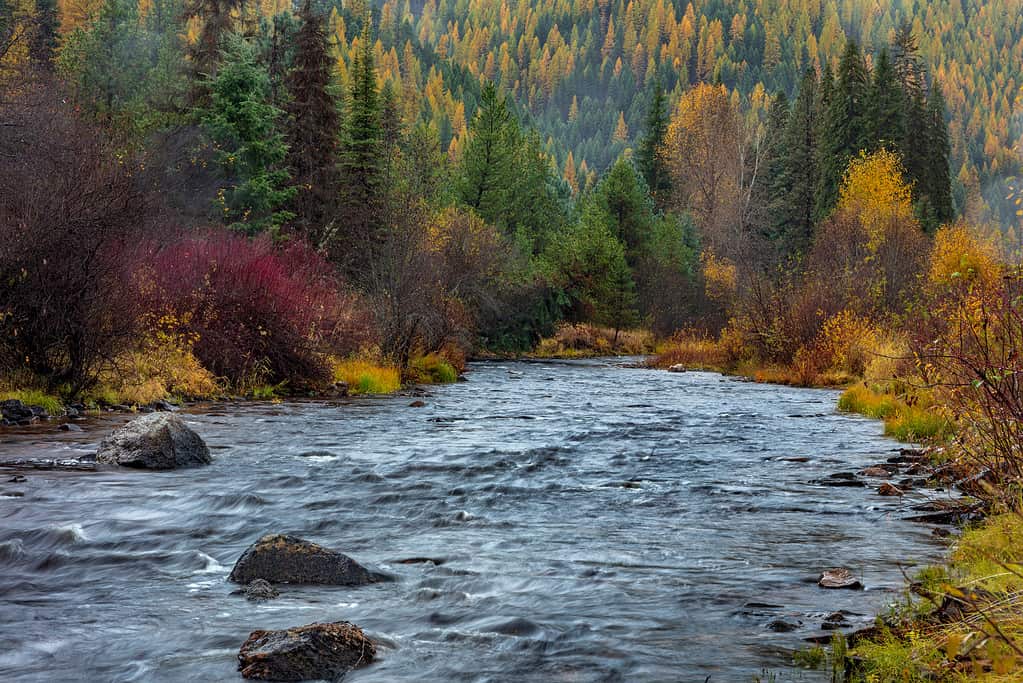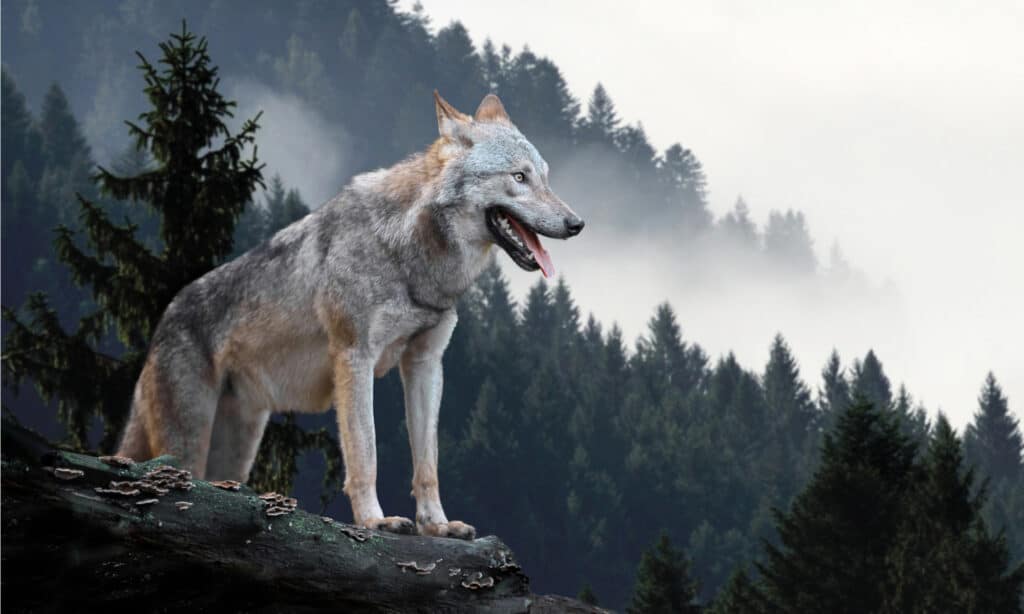As one of the driest states in the U.S., Montana only gets around 15 inches of rain in an entire year! But a few areas in the Big Sky State get a bit more precipitation, with the rainiest place in Montana getting almost twice the yearly average for the state. Below, we’ll take a closer look at Montana’s wettest town, some interesting facts about the area, and the local wildlife.
Montana’s Rainiest Town
The rainiest place in Montana is the town of Haugan. Its average precipitation is 29.92 inches per year. While this is a modest amount of rainfall for most other U.S. states, it’s a great deal of rain for the dry state of Montana. For reference, the state average is just 15.2 inches of precipitation per year.
Haugan, Montana gets its name from Norwegian native banking and railroad executive H.G. Haugan, who lived from 1840 to 1921. Notably, Haugan was the land commissioner for Chicago, Milwaukee, and St. Paul Railroad, better known as the Milwaukee Railroad. This railway operated in the Midwest and Northwestern U.S. from 1847 to 1986. After retiring from his career in railroad management, Haugan became a partner and shareholder of the Chicago banking firm Haugan and Lindgren and the director of the State Bank of Chicago.
Interestingly, Haugan is actually an unincorporated area, meaning it’s so small and remote it essentially lacks a local government. Additionally, the town was destroyed in the Great Fire of 1910, a wildfire that decimated three million acres of land across Northern Idaho and Western Montana. It managed to recover from this tragedy, even having a post office that operated for around 70 years from 1911 to 1983.
Haugan Population and Demographics

Haugan is surrounded by the two-million-acre Lolo National Forest, which boasts 12 campgrounds and 700 miles of hiking trails.
©Danita Delimont/Shutterstock.com
While Haugan has a unique and storied history, its population is very sparse today. As of 2020, its entire population was only 58 residents. Its population density is 90.77 per square mile or 35.05 per square kilometer. The entire town is just 0.64 square miles.
In terms of elevation, Haugan rests at around 3,143 feet. The St. Regis River flows through the area, a 32.5-mile tributary of the Columbia River’s Clark Fork. It’s also surrounded by the two-million-acre Lolo National Forest, which boasts 12 campgrounds and 700 miles of hiking trails.
Finally, Montana’s rainiest place is also home to the Savenac Nursery Historic District, which operated from 1907 to 1969 and was once one of the Western U.S.’s oldest USDA Forest Service tree nurseries. In 1999, Savenac was even listed in the National Register of Historic Places.
Where Is Haugan Located on a Map?
Haugan is located in Mineral County just 16 miles away from the Idaho border. It is 90 miles’ drive west of Missoula via Interstate 90. It’s bordered by the towns of Superior and Alberton.
Wildlife Near Haugan, Montana
Although its human population is very low, Haugan is home to a wide range of animals, with its local wildlife including some of Montana’s most unique, fearsome, and beautiful animals. In particular, the Lolo National Forest nearby hosts an incredible range of around 60 species of mammals, 20 different kinds of fish, and 300 unique bird species. Below, we’ll highlight three of Haugan’s most amazing animals!
Grizzly/North American Brown Bear (Ursus arctos horribilis)
Perhaps Haugan, Montana’s most fierce and breathtaking animal is the grizzly bear, also known as the North American brown bear. The origin of its common name is heavily disputed. Explorers Lewis and Clark were the first ones to describe it as “grisley,” which some historians have interpreted as either meaning grizzled, as in having brown hair with grayish tips, or grisly, meaning horrifying or gruesome.
The grizzly bear as we know it today originated in Eurasia and made its way to North America around 50,000 years ago. Biologists originally classified it as having 86 unique species in the 1800s, but by the 1950s, just one species remained.
Weighing anywhere from 300 to 800 pounds, with males being about twice as heavy as females, the average grizzly is an absolutely massive animal. It has distinctly brown fur with gray tips along the neck and back. Only around 60,000 of them remain in North America, with around half of these residing in Alaska. Around 1,000 of them live in the Wyoming, Montana, and Idaho tri-state area.
Bighorn Sheep (Ovis canadensis)
The bighorn sheep is one of Montana’s most popular animals (to big game hunters, at least). Getting a license and tag to hunt one of these majestic and agile animals is tricky, with only around 1,000 tags issued nationally per year. This ensures the bighorn’s populations aren’t overhunted and can continue to thrive.
Fast, muscular, and equipped with extra-sharp senses, the bighorn sheep is right at home in Montana’s mountainous, dry, and harsh environment. Its hooves are perfect for gripping the sides of steep peaks. Meanwhile, its large and far-set eyes give it an exceptional range of vision. It can also run at speeds of up to 30 miles an hour and scramble up cliffs at 15 miles per hour.
Though both sexes of bighorn sheep have horns, only males have the large, curled horns prized by big game hunters. Males also use their horns to ram into one another while competing for mates. Their skulls are reinforced with an especially thick layer of bone to absorb the impact of headbutting one another! The Lolo National Forest is a prime spot for observing bighorn sheep, with Montana’s rainiest town being very close to the Koo-Koo Sint Bighorn Sheep Viewing Site.
Timber Wolf (Canis lupus lycaon)

Both main varieties of the timber wolf are lean and agile yet muscular, weighing around 50 to 70 pounds.
©Volodymyr Burdiak/Shutterstock.com
Finally, let’s take a look at the timber wolf, also known simply as the eastern wolf. Interestingly, taxonomists have long debated its exact genetic history and taxonomy. Some experts consider the species to be a subspecies of the gray wolf, some believe it’s a subspecies of the red wolf, while others believe it’s an entirely separate species.
The timber wolf is actually divided into two main forms, a larger and smaller variety. The larger form, the Great Lakes wolf, mainly lives throughout the Great Lakes area around Wisconsin, Minnesota, and Michigan.
Meanwhile, the smaller variety, the Algonquin wolf, primarily resides in Eastern Canada. Though the two forms differ in size, they are both easily recognizable by their grayish-brown coats with a reddish or cream-toned chest. There is also plenty of overlap in the two forms’ geographic ranges. Both can be found as far west as Washington state.
These wolves are lean and agile yet muscular, weighing around 50 to 70 pounds. Like most sexually dimorphic mammals, males are slightly larger and heavier than females. They can live for up to 15 years in the wild, though the average is around three to four years.
The photo featured at the top of this post is © iStock.com/Matt Anderson
Thank you for reading! Have some feedback for us? Contact the AZ Animals editorial team.






